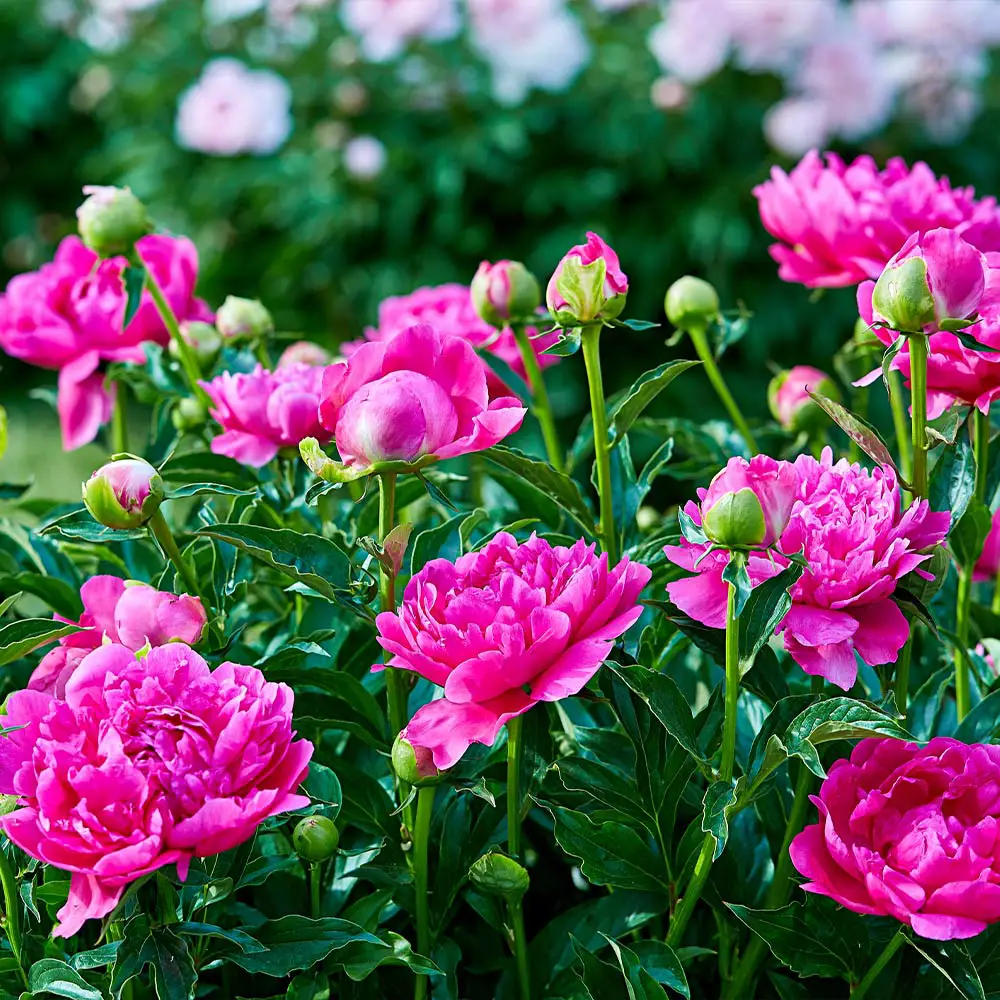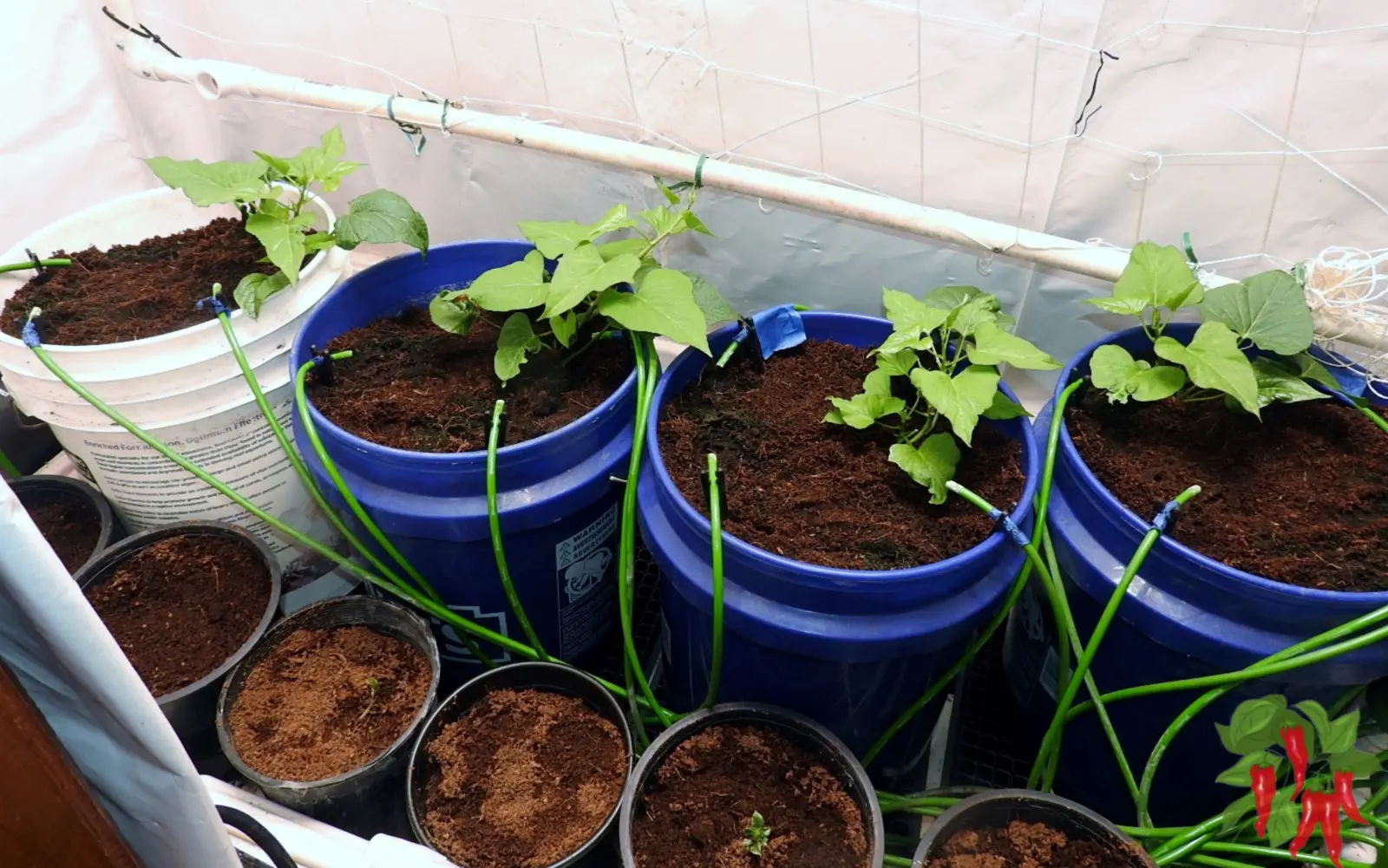This post contains affiliate links. If you buy something from one of our links we may earn a commission. Thanks

Discover the joy of growing rosemary in pots indoors! With our simple, step-by-step guide, your indoor garden will be fragrant and fresh all year round.
To grow Rosemary in pots, use well-draining soil and a pot with drainage holes. Place the pot in a sunny location, receiving at least 6-8 hours of sunlight daily. Water when the top inch of soil feels dry. Fertilize sparingly and ensure good air circulation to prevent diseases.
Have you ever dreamed of adding a touch of Mediterranean flavor to your home?
Well, growing rosemary in pots indoors is a wonderful way to do just that!
With its aromatic leaves and charming blue flowers, rosemary can transform your living space into a fragrant herb garden.
And the best part? You can enjoy fresh, home-grown rosemary in your dishes all year round!
Let’s delve into the exciting world of indoor gardening and explore how you can successfully grow this aromatic herb in your home.
Growing Rosemary In Pots Indoors
Step into the fresh, aromatic world of growing rosemary in pots indoors.
If you’ve been looking for a way to brighten your home and spice up your cooking, you’re in the right place.
This guide will take you through all you need to know – from understanding what rosemary is and its numerous benefits, to all the tips and tricks for year-round indoor cultivation.
We’ll tackle everything from light requirements and the perfect soil mix, to maintenance, repotting, and even propagation.
Get ready to unravel the secrets of successful indoor rosemary gardening!
Understanding Rosemary: Origin and Characteristics
First things first, let’s get to know rosemary. Originally from the Mediterranean, rosemary is an evergreen herb that’s as rich in history as it is in fragrance and flavor.
This hardy plant is part of the mint family, which also includes other perennial herbs like basil and oregano.
Its needle-like leaves and beautiful flowers (which can be blue, pink, or white) are a delight to the senses.
According to Wikipedia
Salvia rosmarinus, commonly known as rosemary, is a shrub with fragrant, evergreen, needle-like leaves and white, pink, purple, or blue flowers, native to the Mediterranean region. Until 2017, it was known by the scientific name Rosmarinus officinalis now a synonym.
It is a member of the sage family Lamiaceae, which includes many other medicinal and culinary herbs. The name “rosemary” derives from Latin ros marinus (lit. ’dew of the sea’).[6][7] Rosemary has a fibrous root system.
Size Matters: Typical Indoor Rosemary Plant Size
Now, let’s talk size. Indoor rosemary plants usually grows to be about 1 to 3 feet tall.
This makes it a perfect companion for your kitchen window sill or a sunny corner of your living room.
Remember, its growth can be controlled by the size of its pot and regular pruning.
Benefits Of Rosemary Plant Indoors
Having rosemary in your home brings numerous benefits.
On an aesthetic level, its silvery-green foliage and pretty flowers make it a pleasing addition to any interior.
But beyond beauty, it’s a culinary powerhouse, adding a distinctive flavor to dishes, from roasted meats to artisan breads.
Health-wise, rosemary is a star too. It’s packed with antioxidants and anti-inflammatory compounds.
Some studies even suggest that it may improve memory and mood!
A Year-Round Guest: Growing Rosemary Indoors All Year
Here’s the best part. You absolutely can grow rosemary indoors year-round.
While it loves sunshine and well-drained soil, with the right care, it can adapt to the indoor environment.
We’ll delve into the specifics of those conditions later in this guide.
With the right light, temperature, and water, your indoor rosemary can thrive all year long, giving you an endless supply of this aromatic herb.
How to grow Rosemary indoors
If you’re looking to bring a dash of Mediterranean flair into your home, you’re in the right place.
Growing rosemary indoors might seem a little challenging at first, but with a few tips and tricks up your sleeve, you’ll soon find it a rewarding and enriching experience.
From picking the perfect pot to nurturing your herb with the right amount of light and water, we’ll walk you through each step of the process.
So, get your green thumbs ready, and let’s dive into the world of indoor rosemary cultivation!
Rosemary Light Requirements: Let There Be Light
The mighty rosemary plant, native to the Mediterranean, is used to basking in plenty of sunshine.
When growing it indoors, you’ll want to mimic this by placing your rosemary in a bright, sunny spot.
South-facing windows often provide the most sun, but any location that gets about six to eight hours of direct sunlight a day should suffice.
Rosemary Watering: Just the Right Amount
Contrary to some thirsty houseplants, rosemary prefers its soil on the dry side.
Too much water can lead to root rot, a condition that’s definitely not on your rosemary’s wish list.
So, wait until the top of the soil is dry to the touch before giving it a drink.
And when you do water, do so thoroughly, allowing the water to drain out of the pot’s bottom.
Watering Rosemary in Pots: Quenching Potted Thirst
Watering rosemary in pots is a bit different from watering garden plants.
Potted plants usually dry out more quickly, especially in terracotta pots, so you may find you need to water your rosemary a little more frequently.
Just remember: always check that the top layer of soil is dry before reaching for the watering can.
Rosemary Soil: The Perfect Mixture
When it comes to soil, rosemary isn’t overly picky. However, it does appreciate well-draining soil to avoid those dreaded soggy roots.
A mix of coco coir and perlite can provide the perfect environment, promoting good drainage while still retaining enough moisture to keep your plant happy.
Rosemary Pot Size: Room to Grow
Your rosemary will appreciate a pot that offers plenty of room for its roots to spread out.
A pot that’s around 12 to 16 inches in diameter usually works well for a mature plant.
If your rosemary is still a baby, start it off in a smaller pot and gradually increase the pot size as it grows.
Fertilizing Rosemary: Time for a Feed
Your rosemary will benefit from occasional feeding, especially during its active growing season (spring and summer).
An all-purpose liquid fertilizer diluted to half-strength should do the trick.
Feed your rosemary once every 4-6 weeks during these seasons, but avoid fertilizing in winter when growth slows down.
Rosemary Temperature Tolerance: Finding the Sweet Spot
Rosemary is pretty hardy when it comes to temperature. It can handle temperatures between 50 and 80 degrees Fahrenheit (10-27 degrees Celsius).
Keep your plant away from cold drafts and drastic temperature swings to ensure it remains happy and healthy.
Rosemary Humidity: Not Too Wet, Not Too Dry
While rosemary does enjoy a bit of humidity, it doesn’t require the tropical conditions some houseplants crave.
A humidity level of 40-50% is typically sufficient.
If you find your indoor air is particularly dry, you can occasionally mist your rosemary or place its pot on a tray filled with pebbles and a bit of water to increase the humidity around it.
Just make sure the bottom of the pot isn’t sitting in the water.
Rosemary maintenance
Welcome to the maintenance portion of our guide to growing rosemary in pots indoors.
You’ve planted your rosemary, you’re watering it just right, and it’s soaking up the sunlight.
Now, let’s move on to keeping your plant healthy and lush over time. Maintaining your indoor rosemary doesn’t have to be a daunting task.
With a few care tips and a little bit of TLC, you can ensure your plant thrives and continues to add that touch of greenery to your home while also providing you with a readily available herb for your cooking needs.
Let’s delve into how to keep your rosemary in tip-top shape.
Does Indoor Rosemary Go Dormant? – Understanding Dormancy
You might be wondering, does indoor rosemary go dormant like its outdoor counterparts?
Well, indoor rosemary doesn’t experience true dormancy like many plants do in the winter months.
However, it does have a period of slower growth during the cooler months.
This doesn’t mean your plant is unhealthy or dying, it’s just taking a bit of a breather.
During this time, you might notice fewer new sprouts and a general slowdown in growth.
You might need to adjust your care routine slightly during this time, perhaps reducing the amount of water slightly and being mindful of lower light levels.
Regular Upkeep Tasks – Ensuring Long-Term Health
Now, let’s talk about the regular upkeep tasks that will keep your indoor rosemary healthy and thriving.
These tasks involve checking on the plant regularly to catch any issues early, such as discolored leaves, a sign of watering issues or potential disease.
You should also periodically inspect for pests; aphids and spider mites can sometimes become an issue for indoor plants.
Regularly cleaning the leaves can help to keep dust from blocking light absorption.
Lastly, don’t forget to rotate your pot every few weeks to ensure all sides of your rosemary plant get equal exposure to light.
These simple tasks, done regularly, can go a long way in maintaining the health and vibrancy of your indoor rosemary plant.
Pruning Rosemary
Alright, so you’ve successfully established your rosemary plant indoors. It’s healthy, happy, and thriving.
The next step in your plant journey is mastering the art of pruning.
Pruning rosemary is not just about keeping your plant looking neat, although that is a perk.
Pruning encourages new growth, helps control the size of your plant, and can even assist in maintaining plant health by providing good air circulation.
Don’t worry, it’s not as intimidating as it may seem!
In this section, we’ll explore why pruning is important, how often you should do it, and the best techniques to ensure your rosemary continues to flourish.
When to Prune: Timing is Everything
Pruning your rosemary plant isn’t something you do on a whim. The best time to prune is in the spring.
As your rosemary emerges from its slower winter growth period, pruning in early spring encourages new growth and helps to create a bushier plant.
Remember, though, it’s crucial not to overdo it; never remove more than one-third of the plant at a time.
How to Prune Effectively: The Gentle Art of Trimming
Pruning your rosemary plant isn’t just about hacking off branches willy-nilly.
It’s a careful and considered process. You’ll want to remove any dead or damaged branches first.
Then, with a sharp pair of gardening scissors or shears, cut back the stems, always leaving at least five to six leaf nodes on the stem for regrowth.
You should also try to maintain a uniform shape as you prune, focusing on any branches that seem to be growing faster or wider than the rest.
As you prune, remember to turn your pot occasionally to inspect from all angles and ensure an evenly trimmed plant.
Trust me, your rosemary will thank you for the extra effort!
Repotting Rosemary
Let’s delve into the world of repotting rosemary now! It might seem daunting, especially if you’ve never done it before, but I promise it’s not as scary as it seems.
Repotting is a vital part of maintaining a healthy rosemary plant, especially when growing in pots indoors.
So, we’ll talk about the tell-tale signs of a rootbound plant and when it’s time to consider repotting.
Then, we’ll take a step-by-step journey together through the repotting process.
Rootbound Plant Signs and When to Repot: Recognizing the SOS signals
First, let’s talk about rootbound plants. A rootbound plant is one that has outgrown its container, leading its roots to form a tight ball, filling up the entire pot.
This can be detrimental to your rosemary’s health as it reduces the plant’s ability to absorb nutrients and water.
Some clear signs that your rosemary has become rootbound include slower growth, yellowing leaves, wilting despite regular watering, and roots appearing through the drainage hole.
If you see these signs, it’s high time to consider repotting. Usually, this might occur every 2-3 years, but keep a keen eye on your plant’s well-being!
Repotting Step by Step: Making the Move
• Select a New Pot: Choose a new pot that’s about 2 inches larger in diameter than the current one. Ensure it has good drainage.
• Remove the Rosemary Plant: Carefully remove the rosemary from its current pot, ensuring not to damage the root ball.
• Trim the Roots: Trim any excessively long or damaged roots.
• Prepare the New Pot: Fill the new pot with a well-draining soil mixture, such as the coco coir and perlite mix.
• Replant: Place your plant in the new pot, fill around it with more soil, and gently firm it down.
• Water the Plant: Give your newly repotted rosemary a good watering.
• Allow Adjustment Time: Avoid exposing your rosemary to strong sunlight for a few days to let it adjust to the new environment.
And there you have it! You’ve successfully navigated the process of repotting your rosemary plant.
Propagating Rosemary
Ready to multiply your rosemary plants and perhaps share a bit of greenery with friends and family?
Propagating rosemary is a gratifying project that’s not as complicated as you might think.
Whether you’re interested in growing rosemary from cuttings or seeds, or you’re curious about propagating it in water, this section of our guide is designed for you.
By the end of it, you’ll have the knowledge to create a rosemary forest right at your home!
Let’s explore the fascinating world of rosemary propagation together.
Growing Rosemary from Stem Cuttings
One of the easiest ways to grow rosemary is by taking cuttings from an established plant.
• Start by choosing a healthy, vigorous stem on the mother plant, ideally one that’s not currently flowering.
• Cut about a 3-inch segment, stripping the leaves from the bottom half.
• Dip the cut end into a rooting hormone, and then stick it into a well-draining soil mix, like coco coir or peat moss.
• Keep the soil moist but not soggy and wait for the magic to happen!
• In a few weeks, roots should start to develop.
Propagating Rosemary in Water: A Root’s Journey
Yes, you read that right! You can actually grow rosemary in water.
• Cut a healthy piece from a rosemary plant.
• Strip the leaves from the bottom two-thirds of the cutting, then simply place it in a glass of water, ensuring that the water level doesn’t touch the remaining leaves.
• Change the water every few days to keep it fresh.
• In a couple of weeks, roots should begin to form. Once they’re about an inch long, you can transplant your water-born rosemary to the soil.
Growing Rosemary from Seed: The Patient Gardener’s Path
While it may take more time than the other methods, growing rosemary from seed can be a rewarding process.
Start by sowing your rosemary seeds in a seed tray filled with a well-draining seed-starting mix.
Keep the seeds moist and in a warm area with lots of indirect sunlight.
Patience is key here, as germination can take anywhere from 15 to 25 days.
Once the Rosemary seedlings are large enough to handle, you can transplant them into individual pots and then eventually to their final destination.
Rosemary problems
Let’s dive into it! Despite our best efforts, sometimes our beloved green companions run into a bit of trouble. But don’t worry!
When it comes to growing rosemary in pots indoors, we’re going to tackle any issues head-on.
We’ll identify common pests and diseases that may plague your rosemary plant and share practical solutions to combat these unwanted visitors.
From preventative measures to treatments, we’ve got you covered.
Because when our rosemary thrives, we all do! Let’s look at some typical rosemary problems and how we can help our plants overcome them.
Common Intruders: Rosemary Pests and Diseases
Oh, the unwanted guests! Spider mites, mealybugs, and aphids may sometimes find their way onto your rosemary plant.
Diseases such as powdery mildew and root rot could also pose a threat if the growing conditions aren’t just right.
But, let’s not fret! Recognizing these problems is the first step towards a healthier plant.
Bug Off: Rosemary Pests Treatment
Time to show those bugs who’s boss! When pests decide to make a home on your rosemary, it’s essential to act quickly.
Use a strong stream of water to dislodge these unwelcome critters initially.
For more stubborn cases, consider introducing natural predators or using organic insecticidal soaps or neem oil.
Always remember, though, prevention is better than cure.
Keep your rosemary’s environment clean and inspect the plant regularly to keep it pest-free.
Back to Health: Rosemary Diseases Treatment
When diseases strike, it’s all about restoring balance.
Powdery mildew, for example, often happens due to poor air circulation or high humidity.
Treat powdery mildew with a homemade solution of 1 tablespoon of baking soda to a gallon of water or consider using an organic fungicide following label directions.
Improving ventilation and lowering humidity can help.
Root rot, on the other hand, is usually a sign of overwatering.
Cut back on the H2O, and consider repotting your rosemary in fresh, well-draining soil.
It’s all about adjusting the care to bring your rosemary back to its prime.
Winterizing Rosemary
Ready for a winter retreat? As the temperature drops and the snow starts to fall, growing rosemary in pots indoors becomes a delightfully cozy proposition.
Yet, it’s not just about bringing the pots in from the cold. There’s more to winterizing your rosemary than you might think.
From understanding the plant’s cold tolerance to adjusting its care for the indoor environment, we’ll guide you through the process, ensuring your rosemary thrives throughout the chilliest months.
So, let’s get our green thumbs ready for winter, shall we?
Winterizing Your Potted Rosemary
• Transition Gradually: You don’t want to shock your rosemary by moving it suddenly from the chilly outdoors to the dry warmth indoors.
Begin by bringing it in at night when temperatures start to drop, then slowly increase the time it spends indoors over a week or two.
• Choose the Right Spot: Indoors, your rosemary will still need lots of light, preferably six to eight hours a day.
Find a sunny south-facing window if possible. If natural light is limited, consider supplementing with a grow light.
• Maintain Humidity: Indoor heating can dry out the air, which isn’t ideal for rosemary.
Place your pot on a tray of watered pebbles to increase humidity around the plant, but make sure the pot isn’t sitting in water.
• Adjust Watering: You’ll probably need to water your rosemary less frequently indoors since it will dry out more slowly.
Make sure the top of the soil is dry before watering.
• Watch for Pests: Rosemary can be prone to pests like spider mites, especially in dry indoor conditions.
Keep an eye out for any signs of infestation.
Understanding Cold Tolerance
Low Temperature Limits: Rosemary is quite cold hardy and can tolerate temperatures as low as 10-15 degrees Fahrenheit.
It falls into USDA zones 8 and 9. This makes it more resilient than many other herbs, but it’s still a good idea to bring it indoors when frost threatens.
Responding to Cold Weather: If temperatures are going to dip below Rosemary’s comfort zone, bringing it indoors is your best bet.
If you can’t bring it inside, consider using plant covers or cloths to help insulate your rosemary from the cold.
So, with a bit of preparation and the right approach, your rosemary can thrive indoors during the winter months, providing you with its fragrant leaves and a splash of green when everything else outside is dormant.
Rosemary plant care outdoor
Alright! Now, you might be thinking, What if I want to let my rosemary enjoy some fresh air? Good news!
Rosemary is just as happy outdoors as it is indoors.
Growing rosemary in pots outdoors is an excellent way to enjoy this aromatic herb’s beauty while still having easy access to its savory leaves for your kitchen adventures.
In this section, we’ll take a look at how to ensure your rosemary thrives under the open sky.
We’ll cover important aspects like where to position your plant, how to protect it from harsh weather, and how to deal with outdoor pests.
Ready to embark on this outdoor growing journey? Let’s dive in!
Differences in Light Exposure
In the great outdoors, rosemary will typically have access to more direct sunlight compared to its indoor counterpart.
While rosemary enjoys lots of sunlight, remember to protect your plant from the harsh midday sun, particularly in hotter climates, to prevent the leaves from scorching.
Watering Differences
When growing rosemary outside, you might need to water it a bit more frequently, especially in hot and dry weather.
However, don’t overdo it! Rosemary is a drought-tolerant plant and prefers well-drained soil.
So, ensure that your rosemary isn’t sitting in waterlogged soil.
Dealing with Weather Changes
Outdoor rosemary plants will need a bit more attention when it comes to weather changes.
In hot weather, ensure your plant has enough water and shade during the hottest parts of the day.
In cold weather, consider bringing your rosemary plant indoors or providing some form of frost protection.
Pest Management
Rosemary planted outside might face more pests compared to indoor plants.
Keep an eye out for common pests like aphids and spider mites. Treat any infestations early to keep your plant healthy.
Soil and Fertilization
Outdoor rosemary might need a bit more feeding compared to indoor plants, given it has access to more sunlight and thus can photosynthesize more.
However, remember that rosemary doesn’t need overly rich soil – a good potting mix with some slow-release fertilizer should suffice.
Pot Considerations
When keeping rosemary outdoors, make sure the pot is sturdy enough to withstand wind and weather changes.
Consider a pot with good drainage and enough weight to prevent it from toppling over in strong winds.
Pruning and Maintenance
Pruning might be more frequent for outdoor plants, especially if you’re aiming for a particular shape or size.
Besides, regular pruning encourages bushier growth, which can result in a more robust plant.
Transitioning Between Indoors and Outdoors
If you’re planning to move your rosemary between indoors and outdoors, remember to do it gradually.
Sudden changes in the environment can stress the plant.
Start by placing it outside for a few hours each day, gradually increasing it until it’s ready to stay outside full-time (or vice versa if bringing it indoors for the winter).
Growing Rosemary Indoors FAQ
Are you scratching your head, trying to figure out the best way to keep your potted rosemary thriving?
Perhaps you’re wondering if it’s possible to have it flourish indoors all year long, or maybe you’re curious about how often you should be watering it.
If so, you’ve landed in the right place! In this section, we’ll address some of the most frequently asked questions about growing rosemary in pots indoors.
By tackling these common queries, we aim to make your rosemary nurturing journey as seamless and successful as possible.
Let’s get those questions answered!
Q: Does Rosemary grow well indoors?
A: Absolutely! With the right conditions—ample sunlight, good drainage, and the right temperature—rosemary can thrive indoors.
Q: Can I bring my potted Rosemary inside for the winter?
A: Yes, you can. In fact, it’s recommended in colder regions where winter temperatures drop below its tolerance levels. Just ensure it gets enough sunlight and isn’t exposed to drafts.
Q: Does potted Rosemary come back every year?
A: As a perennial plant, rosemary can live for several years and continue growing with proper care and optimal conditions.
Q: How do you take care of potted Rosemary?
A: Caring for potted rosemary involves ensuring it gets 6-8 hours of sunlight daily, watering when the top inch of soil is dry, and maintaining a temperature between 60-70 degrees Fahrenheit.
Q: How long do potted Rosemary plants live?
A: With proper care, a potted rosemary plant can live for several years, often up to 5-10 years, sometimes longer.
Q: How do you keep Rosemary alive in the house?
A: To keep rosemary alive indoors, provide it with plenty of sunlight, water it appropriately (when the top inch of the soil is dry), and ensure it has good drainage to avoid root rot.
Q: Can I leave potted Rosemary outside in winter?
A: It depends on your local climate. If temperatures regularly drop below 30 degrees Fahrenheit, it’s better to bring your rosemary plant indoors to protect it from the cold.
Q: What is the best potting mix for Rosemary?
A: Rosemary prefers well-draining soil. I like 75% coco coir and 25 perlite. Another good mix would be one part coarse sand or perlite to three parts quality potting soil, which provides adequate drainage.
Q: Does potted Rosemary need full sun?
A: Yes, rosemary thrives in full sun, needing at least six to eight hours of direct sunlight per day.
Q: How often should I water Rosemary?
A: Water your rosemary plant when the top inch of the soil feels dry to the touch. It’s crucial to avoid overwatering as this can lead to root rot.
Growing Rosemary In Pots Indoors Final Thoughts
You’ve ventured through the verdant world of indoor rosemary care, uncovering tips and tricks about everything from propagation to winterization.
It’s clear that with the right nurturing, your aromatic companion can thrive in the cozy confines of your home.
Whether it’s basking in a sunny window or adding flavor to your favorite dish, growing rosemary in pots indoors is an enriching and rewarding experience.
As we wrap up this verdant journey, let’s revisit the key points and ensure you’re ready to become the ultimate indoor rosemary caretaker.
Recap of key points
Rosemary is a versatile, aromatic herb with multiple uses and benefits, not to mention its origins in the Mediterranean region.
When grown indoors, Rosemary can thrive year-round with the right conditions, including ample light, consistent watering, suitable pot size and soil mixture, and appropriate temperature and humidity levels.
Regular maintenance, such as pruning and repotting, can help keep your rosemary plant healthy and vibrant.
Be on the lookout for rootbound signs and don’t hesitate to upgrade your pot when the time is right.
Propagation is an exciting part of indoor rosemary care, with different methods available including cuttings, water propagation, and seed growth.
Watch out for potential problems like pests and diseases, and be prepared with the right treatment strategies to maintain your plant’s health.
As winter comes, special care is needed for your potted rosemary. Understanding its cold hardiness and the process of winterization will ensure its survival during colder months.
Outdoor care differs from indoor care, with elements such as light, temperature, and watering conditions varying significantly.
Encouragement For Growing Rosemary In Pots
Growing rosemary in pots indoors is a delightful journey. It might take some patience and a bit of a green thumb, but the aromatic rewards are worth every moment.
So, roll up your sleeves and get ready to embark on this fragrant adventure. Your rosemary plant is ready to grow with you. Happy planting!
Read about the 20 Benefits Of Keeping Indoor Plants

















